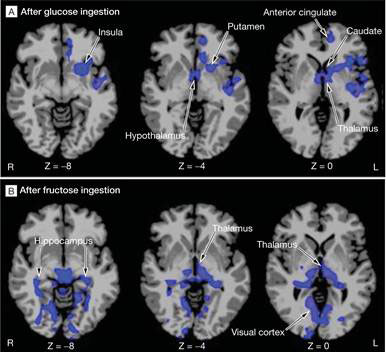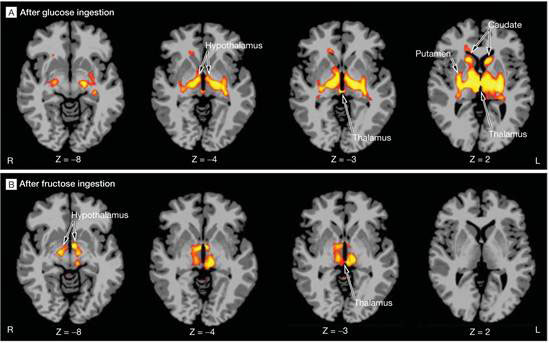A new brain imaging study finds fructose, but not glucose, causes distinct brain activity associated with a lack of fullness and satiety Dr. Eva Sirinathsinghji
A new study finds that fructose consumption has distinct effects on brain regions that regulate appetite, a possible mechanism for ‘ever-eating’ and the widespread rise in obesity and other related disorders.
The study, led by Dr Robert Sherwin at Yale University in the US, used magnetic resonance imaging (MRI) techniques to look at the activity of brain regions associated with appetite and reward systems, to assess how they respond to fructose versus glucose [1].
Increases in fructose consumption have risen dramatically since the creation of high fructose corn syrup (HFCS). HFCS has largely replaced table sugar as the most common industrial sweetener, especially in the US where most processed foods including soft drinks contain high levels of the sugar substitute. Industrial-scale, cheap over-production of corn since the Nixon era in the early 1970s laid the foundations for the wide-spread use of HFCS, and this continues today with the US devoting roughly a quarter of its agricultural land to corn crops, the majority of which are now genetically modified (GM).
Rise in HFCS consumption over the last few decades appear to correlate with the sharp increase in obesity and other diet-related disorders including diabetes, suggesting fructose as a major contributory factor. The HFCS used in beverages is usually 55 % fructose and 41 % glucose (HFCS55). Since its introduction, higher quantities of HFCS than sucrose is added despite it being sweeter (sucrose is a disaccharide of both fructose and glucose). The excessive consumption of fructose is therefore considered a major health risk.
In the new study, 10 people consumed fructose or glucose drinks 15 minutes before their brains were analysed for cerebral blood flow, an indirect measure of brain activity. They then mapped out the regions of the brain with significantly reduced blood flow; very different patterns emerged with the two sugars (Figure 1).

Figure 1 Reduced cerebral blood flow (marked in blue) after glucose (upper panel) and fructose ingestion at different sections of the brain on fMRI
Glucose lowered cerebral blood flow in the hypothalamus, a region that controls appetite and fuel sensing and regulates hunger, among other metabolic processes including thirst, and circadian rhythm. Glucose also reduced activity in other brain regions that are thought to act in synchrony to read a person’s metabolic state and drive motivation and reward - the thalamus, insula, anterior cingulate and striatum.
Fructose reduced activity in the posterior thalamus, the posterior cingulate cortex, fusiform gyrus, visual cortex and the hippocampus, a region most noted for its role in learning and memory and mediates emotional responses to food. Hippocampal activity in rodents has previously been associated with inhibition of feeding behaviour. Functional connectivity after fructose consumption only increased between the hypothalamus and the thalamus.
Functional connectivity analysis was also carried out to identify brain regions that are temporally and thus functionally related. Again the two sugars gave very different patterns (Figure 2).

Figure 2 Functional connectivity increase (bright yellow and red patches) after glucose (upper panel) and fructose (lower panel) at different optical sections of the brain
Glucose increased functional connectivity between the hypothalamus and the striatum and thalamus, other regions involved in feeding behaviour. Fructose on the other hand, only increased functional connectivity between the hypothalamus and the thalamus.
Behavioural testing of the participants found that fructose led to reduced feelings of both satiety and fullness.
Metabolic experiments found glucose but not fructose, to induce a significant rise in blood insulin, a hormone that acts centrally to induce satiety and dampen reward value of food. Lastly, they were able to detect fructose in the brain of rodents following peripheral infusion of fructose, showing its ability to penetrate the blood-brain barrier.
All together, these results indicate that the brain responds differently to fructose, leaving individuals feeling less fulfilled and therefore more susceptible to over-eating.
This study is not the first to establish a link between fructose and obesity/metabolic disorders. A long-term feeding study in rats found that a 6-month high fructose diet followed by a 2-week high fat diet led to weight gain resulting from the development of leptin resistance during the high fructose diet [2]. Leptin is a hormone released by adipose tissue as a satiety signal after eating. Fructose has also been shown to provoke feeding in rodents as well as reduce circulating satiety-related molecules including insulin and glucagon-like polypeptide 1 (GLP-1) [3].
Indeed, fructose has been used by scientists as a tool for generating diabetes and/or obesity animal models in research. Most recently, a primate model of diabetes was induced by a high fructose diet. The rhesus monkeys developed insulin resistance and many features of the metabolic syndrome, including central obesity, dyslipidemia (abnormal blood lipid levels e.g. cholesterol/fat) and inflammation within a short period of time; moreover, a subset of monkeys developed type-2 diabetes [4]. The authors went on to suggest that due to the ‘rapidity with which the metabolic changes occur’, that fructose consumption was a ‘practical and efficient’ system to adopt for such research studies.
Other research studies have shown that fructose is metabolised in a different way from glucose, with fructose having a higher propensity to be converted into body fat, a process called lipogenesis. Prolonged fructose, but not glucose consumption has been shown to induce de novo lipogenesis in the liver [5]. Similarly, it is thought to promote visceral over subcutaneous fat deposition, a more common feature of metabolic disorders including diabetes [6].
Article first published 25/02/13
Article first published 25/02/13
Comments are now closed for this article
There are 5 comments on this article.
Stuart Krichauff Comment left 26th February 2013 20:08:41
Very interesting,
Was any differentiation between naturally occuring fructose and synthetic chemical corn fructose made.
Do primates on a natural fruit diet suffer the problems found in this article.
Eva Sirinathsinghji Comment left 27th February 2013 06:06:21
Stuart, thanks for the interesting question. I do not know of animals suffering from such diet-related problems. Many species including rhesus monkeys do however eat a variety of foods that contain fibre from fruit, nuts, seeds, roots, bark and leaves, which is thought to lower blood sugar levels. Many species also supplement their diets with other food types including insects and bird eggs. Soft drinks however, and many juices for that matter, do not contain the equivalent fibre content. Soft drinks also have very high levels of fructose. For example, an average can of soft drink contains 23g while a cup of tomatoes contains 2.5g so I think the amount and the context of how it is consumed is different between wild animals and manufactured food products which are far from representing a natural diet. There was no mention of any difference between natural vs synthetically made fructose but I would suspect that there would not be a difference.
Rory Short Comment left 27th February 2013 01:01:20
The same question as that of Stuart occurred to me, fruit eating bats do not have weight and diabetes issues as far as I know.
Helen Comment left 28th February 2013 21:09:52
There are several useful fructose content of foods database. Just google 'fructose counter' or 'sugar counter'.
Gnarlodious Comment left 1st March 2013 08:08:08
You forgot to explain that "corn syrup" is not actually made from corn. That was an appetizing deception cooked up by the ethanol industry to dispose of an otherwise toxic industrial by-product. "Corn syrup" is in fact the metabolic waste of bacterial digestion of corn. Any corn component of the syrup was already used up, and all you suckers are doing is slurping down aspergillus shit.